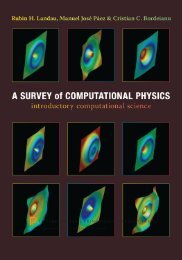Statistical Physics
Statistical Physics
Statistical Physics
- No tags were found...
Create successful ePaper yourself
Turn your PDF publications into a flip-book with our unique Google optimized e-Paper software.
26 2 Entropyand1T = ∂S (∂E = k B ln 1+ N ). (2.8)EExpressing E in terms of T , we obtainNE =exp(1/k B T ) − 1 . (2.9)This form is known as the Bose distribution function, and we shall encounterit when we consider the vibration of two-atom molecules, black-body radiation,and the heat capacity of solids. A detailed discussion of this distributionfunction will be given in Chap. 10. You should notice that to obtain theseresults, we have implicitly taken δE to be 1 yen. Also, we have approximatedthe stepwise function W (E,N) by a smooth function after using Stirling’sformula, by treating E as a real number.RemarkWhen two systems of the same size are united into one, E, N, andV aredoubled. In this case the entropy should also be doubled. Otherwise, the temperaturedefined by (2.2) will change after the union. The entropy S (2.7) hasthis property. Similarly, the entropies of all the systems that we consider inthis book have this property. If we want to define an entropy with this propertystarting from W , taking the logarithm of W is necessary. Then what isthe reason why W was chosen as the starting point for obtaining S? I thinkthat there is no a priori, logical reason to choose W . This choice was discoveredby the genius Ludwig Boltzmann, probably after much trial and error.We can imagine how excited he was when he found that this entropy and thethermodynamic entropy were the same.2.2 Number of States and Density of StatesThe entropy is defined by the number of microscopic states for a given energy.It can also be calculated from the number of states or from the density ofstates, both of which we define in this section. Any system has a state thathas the lowest total energy out of all possible states. This is called the groundstate in quantum mechanics. We take the origin of the energy so that theenergy of the ground state is zero. We define the number of states Ω 0 (E) asthe number of microscopic states that have a total energy less than or equalto E. By definition, the number of states Ω 0 (E) is an increasing function of E.As in the case of the distribution of money considered above, the energy Emay not be allowed to take a continuous set of values. However, since the totalenergy is the result of a summation over a macroscopic number of molecules,it should be tremendously larger than the unit of energy. Therefore it is legitimateto consider the number of states as a continuous function of E, andwe











![Práctica [PDF] - Universidad de Carabobo, FACYT - computacion](https://img.yumpu.com/48491415/1/190x245/practica-pdf-universidad-de-carabobo-facyt-computacion.jpg?quality=85)




